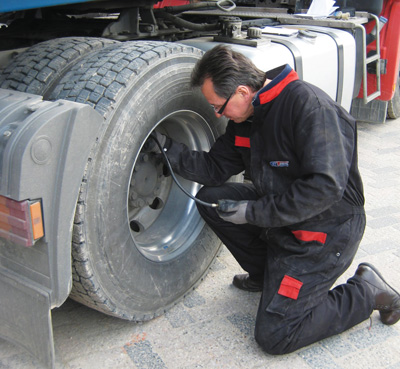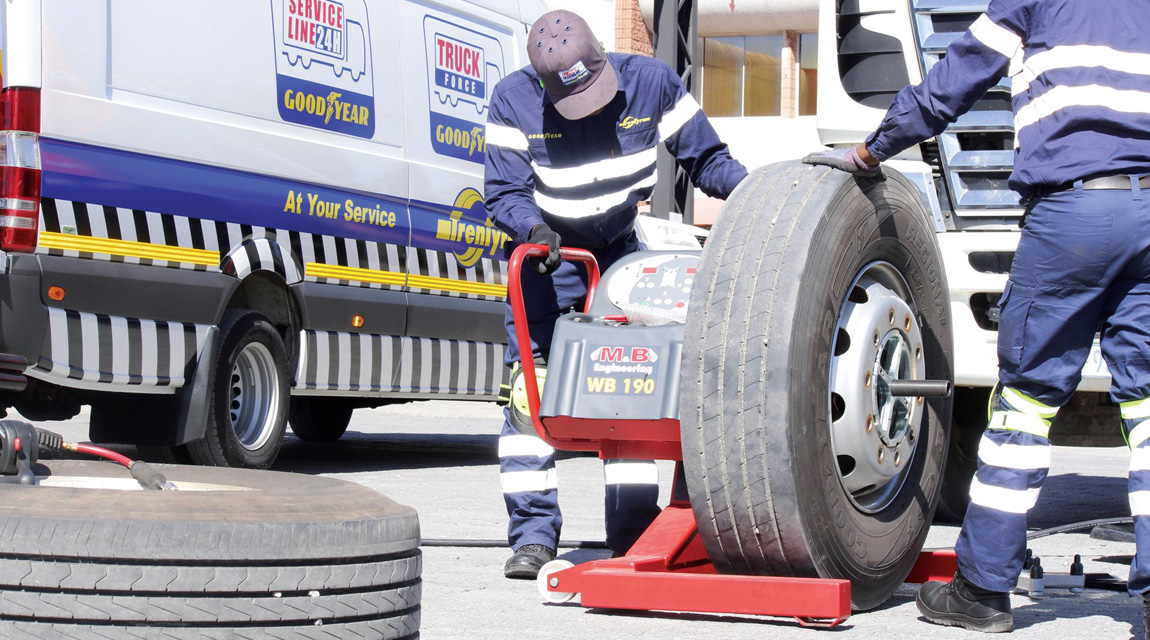Old tyres – ticking time bomb?

Can a tyre expire and, if so, should vehicles and warehouses be checked to identify any potentially aged tyres that might constitute a problem? LIANA SHAW investigates
Much is being said in the international press on the alleged “dangers” of fitting old tyres to one’s vehicle, and by old they are not referring to worn or partially used tyres, but, rather, to a manufactured tyre that has supposedly passed its expiry date.
Brian Ross, investigative reporter for ABC News, recently filed a story suggesting that tyres older than six years were being sold in new tyre shops across America, and that these so-called offending items were little more than ticking time bombs.

A similar report entitled: Expired Tyres, on NBC, highlighted another tyre failure that allegedly had been responsible for the death of a 20-year-old Florida man.
Backed by video footage, the report claimed that the tyres had plenty of wear left. What the footage was not able to reveal, however, was the speed at which the vehicle in question was travelling and what the tyre inflation pressure might have been.
As such, Dan Zielinkski, vice president of communications with the Rubber Manufacturers Association, said that there was no scientific evidence to suggest that ageing had played a role in the incident.
He stated: “Tyres are not milk. Milk will go bad in maybe ten days or so. Tyres and their performance are affected by a number of issues. Right now, there is no information that points to a specific date when tyres will no longer be able to perform solely due to age.”
In response, Heavy Duty Trucking added that there was no room for concern and that achieving a million miles of service over a decade or more (with several retreads), was not uncommon for premium truck tyres these days.
 “That’s what we’ve come to expect from premium tyres and that’s what premium tyres should deliver, assuming they have been well maintained and skilfully retreaded,” said its spokesman.
“That’s what we’ve come to expect from premium tyres and that’s what premium tyres should deliver, assuming they have been well maintained and skilfully retreaded,” said its spokesman.
Old tyres cause over 100 deaths
Meanwhile, wisebread.com claims that more than 100 deaths in the United States (US) have been attributed to “old” tyres failing, but the fact that the National Highway Traffic Administration (NHTSA) is refusing to impose a six-year shelf life on tyres in the US, might further support the opposing claim that there is not enough scientific evidence to warrant such action.
However, the alarm bells continue to ring, seemingly beyond the US. On April 26, an article appeared in Gulf News cautioning motorists that new car tyres should be less than 150 days old. The article claimed that some Dubai residents had fallen into the scam of buying brand new tyres with an old manufacturing date, resulting in a “fail” at the RTA vehicle registration renewal test.
Although the attention has been focusing largely on the passenger tyre market, questions pertaining to the commercial tyre sector, which often operates under heavy loads, are naturally being raised.
Should we be worried about so-called “old” tyres being fitted to commercial vehicles in South Africa and causing accidents?
Vernon Slack, executive manager: SML fleet for Bridgestone SA, tells FOCUS that, while the company’s locally produced commercial tyres all display the date of manufacturing (known as the Department of Transport or DoT number), the only real purpose of the DoT number is for the warranty period.
 “Tyre manufacturers warrant the tyres for a period of five years against manufacturing defects or failures. Commercial tyres do not have an expiry date. Determining an age limit for tyres is difficult since many factors such as sunlight, rain, ozone and storage influence the aging process,” he explains.
“Tyre manufacturers warrant the tyres for a period of five years against manufacturing defects or failures. Commercial tyres do not have an expiry date. Determining an age limit for tyres is difficult since many factors such as sunlight, rain, ozone and storage influence the aging process,” he explains.
Brian Clarke, sales manager at Bandag, agrees. “Tyres are manufactured using natural and/or synthetic compounds that degrade over time. Depending on the storage conditions and the environmental conditions during use (exposure to harsh direct sunlight, heat, chemicals or ozone), this process may be accelerated,” he points out.
Depending on the age and condition, Clarke says it is possible that tyres with degraded rubber could be a risk. “However, if stored and used correctly, it is possible that old tyres are still safe and usable. The reality is that the vast majority of tyres are used well before they become ‘old’. According to Bandag SA Out Of Service Tyre statistics, only 5,5 percent of all tyres scrapped in South Africa are due to fatigue, some of which may be due to age,” Clarke reveals.
Tyres display date of manufacture
In South Africa, all tyres feature a DoT code. At the end of the DoT code there is a four-digit number. This is the manufacturing date of the tyre. The first two digits stand for the week; the other two are the year. For example, if “1610” displayed, the tyre was manufactured during the 16th week of 2010.
“Most tyre manufacturers have a limited warranty that varies according to the law of the country. In South Africa, most new tyre companies will not warrant a claim on tyres older than five years, unless a warranty extension has been provided for in writing. So yes, a tyre can expire. One way to check if a tyre is still safe is to examine the outer sidewall. Reverted rubber presents with a cracked or ‘crazing’ pattern on the sidewall,” Clarke elaborates.
While some authorities believe that a tyre can expire, Slack reiterates that commercial tyres do not have an expiry date. “Accordingly, what is of critical importance is that operators inspect their tyres regularly to check for casing fatigue, cracks and other failures that may be associated with over-aged tyres,” he suggests.
He adds: “Detailed inspection for any casing integrity concerns (of which age is one), is an integral part of the retreading process which is why our inspection teams are well trained to identify any such risks, before the tyre enters the retreading process.”
Slack further emphasises the need for transport operators to be suitably educated to inspect tyre condition so as to be able to make educated decisions on whether to scrap or continue to use an aged tyre.

“Education and awareness are key to this entire process,” he says. “If treated correctly, commercial tyres have a significant, but still finite, lifespan and can last up to eight years. Of course, they do not last forever, but knowing how to manage them and what to look for as early signs of fatigue are key to the industry ensuring safety and also getting maximum return out of the cradle-to-grave ownership and usage cycle of commercial tyres.”
Jim Davis, public relations manager at Goodyear Tyre and Rubber USA, agrees, saying that the age of a tyre really isn’t a key factor, instead, tyre care, maintenance and general condition of the tyre are factors that will affect performance and service life.
“The ageing tyre dialogue has so far been confined to consumer tyres. It just does not apply to heavy truck tyres. The difference is the extent to which truck fleets manage and look after their tyre investment. The key is consistent care,” he tells FOCUS.
Clarke concurs. He says that, in the absence of expiry dates, transport operators can do a lot to ensure that their tyres are safe. “Tyres should be stored away from direct sunlight and away from where they can be exposed to ozone. Furthermore, tyres should be stored away from diesel or exhaust fumes and other petrochemicals that can damage rubber,” he advises.
In addition, Clarke says tyres should be stored on racks or upright. “Do not stack them on their sides and do not paint sidewalls with corrosive chemicals; use only water-soluble tyre paint. Furthermore, do not use corrosive ‘soft soap’ to fit tyres to rims. Use only a water-soluble bead lube,” he suggests.
Clarke says that it is imperative to adopt a first in, first out policy when using new tyres. “Furthermore, inspect each tyre inside and out before fitting to a rim and vehicle,” he says.
Age is not the monster
It is commonly accepted that there is inadequate policing, especially with respect to tyres. Legislation stipulates that in the interests of safety, tyres must sport a minimum of one millimetre of tread around their entire circumference, but a brief glance at the general wear and state of the average tyre in a parking lot tells us that a great number of motorists and operators are not adhering to these guidelines.
Unlike many First-World countries, stats relating to deaths associated with tyre failures are not readily available in South Africa. However, it would be safe to argue that the main culprits for tyre-related accidents in this country would be poor tyre care and maintenance, under-inflation and irregular tyre wear, above any other factor such as ageing.
Published by
Focus on Transport
focusmagsa



